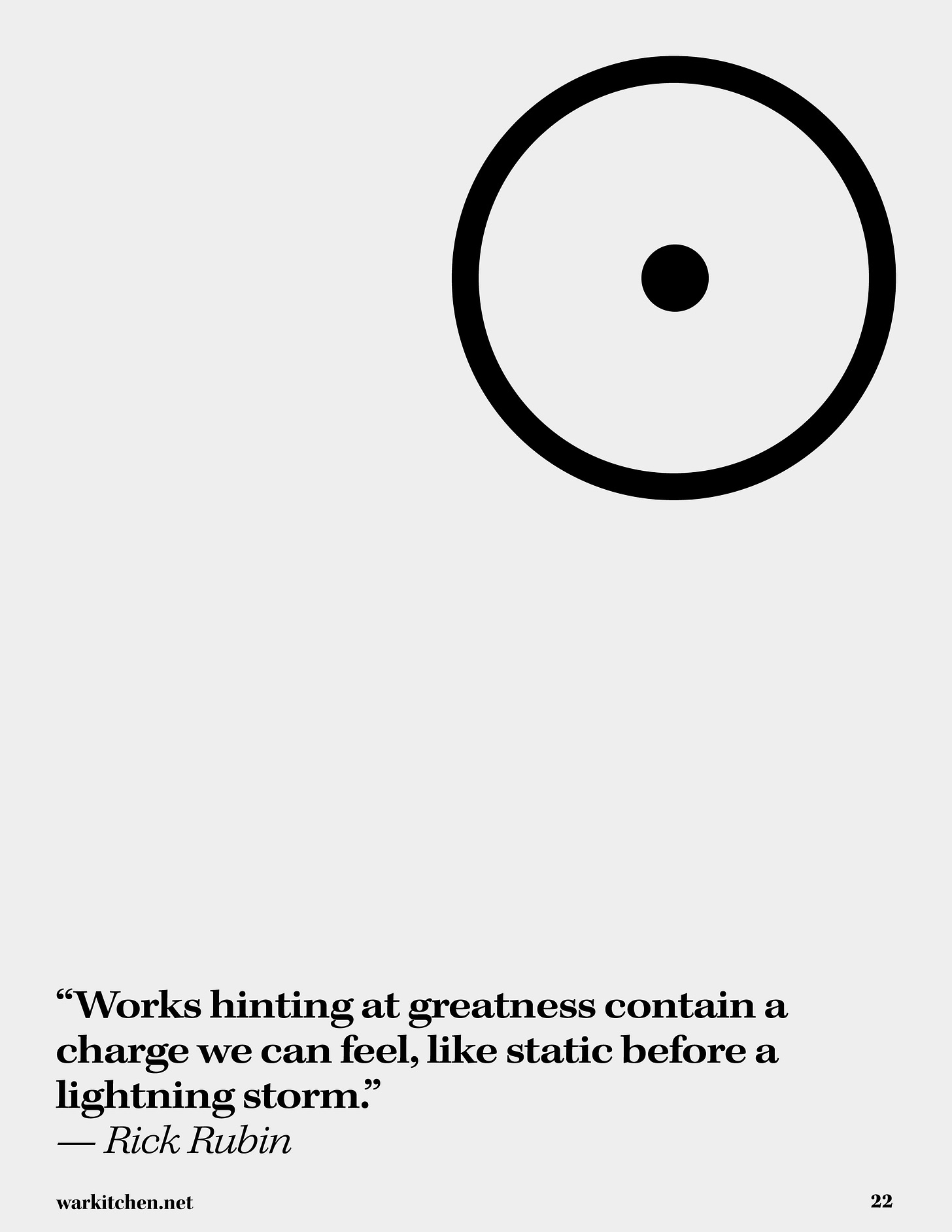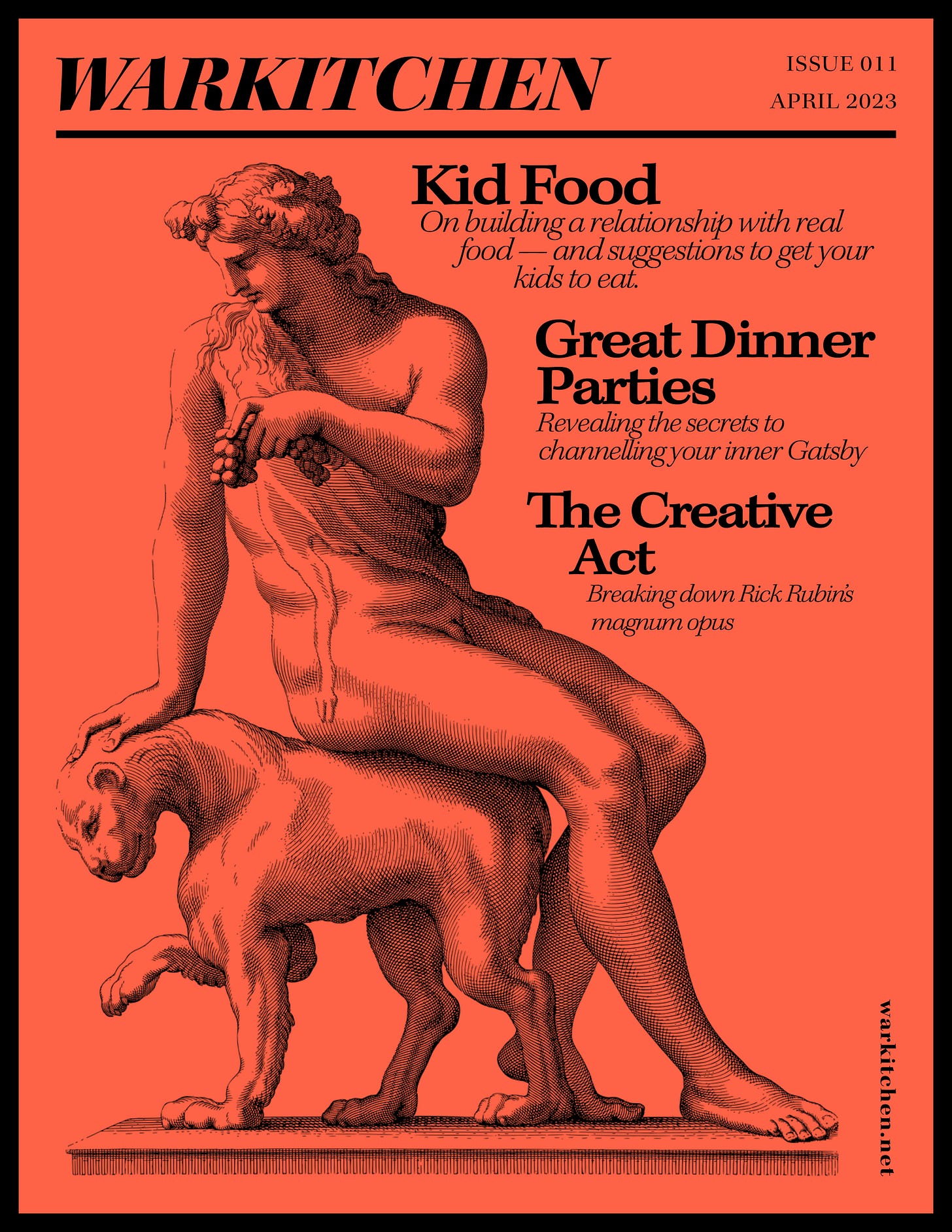The Creative Act: A Way of Being
WARKITCHEN Book Review
The number of highlights and notes I’ve made in this book is astonishing. It’s almost difficult to describe, making it difficult to articulate just how deeply it resonated. It’s been a while since a book has had such a profound impact on me, particularly considering I had no idea who Rick Rubin, the author, even was a mere few months ago. I chanced upon Rubin from clips circulating on Twitter where he spoke about his creative process.“Who is this guy?”, I thought as I watched him talk about how he gets paid for essentially being a visionary, instead of say his practical skills at playing an instrument or the sheer amount of hours he works.
In a few sentences, he redefined the concept of creative work, suggesting that art is not as simple as labor multiplied by time, but rather as if it’s transmuted from a divine source — in a category of one. That was enough for me to place an order for his book, and it came in a form factor that complemented the contents within. It’s creamy white. With a bullseye on the front, all in cloth-bound hardcover that feels really good to the touch. Rubin’s book is divided into 78 chapters or, as he prefers to call them, “Areas of Thought.” In this review, I won’t be going through these chapters methodically, but instead I’ll focus on the key ideas that have captivated me.
The Source
Where do ideas come from? Rubin suggests that thoughts, like ideas, are not intentional, and there’s something magical in the air when an idea sparks in our heads. He likens human beings to antennas, receiving ideas from the universe, stating, “As artists, our job is to draw on this information, transmute it, and share it.”
“Art is a circulation of ideas. What makes them appear new is that they’re combining differently each time they come back. No two clouds are the same.”
Drawing Inspiration
Rubin believes that inspiration can be found everywhere, as the world is filled with signals that can spark creativity at any moment. He offers an interesting metaphor for this process, saying,“You might imagine that the outside world is a conveyor belt with a stream of small packages on it, always going by. The first step is to notice the conveyer belt is there. And then, any time you want, you can pick up one of those packages, unwrap it, and see what’s inside.”
On Perfectionism
Perfectionism can be a double-edged sword, and Rubin addresses the fine line between being a perfectionist and being counterproductive. Yes, the work needs to be great. You seek greatness, but it cannot come at the expense of the art itself. That indicates that there is some fear there. Of what? Only you know.
“Ultimately, your desire to create must be greater than your fear of it.”
On Rules and Boundaries
There’s a popular saying that goes “Rules are meant to be broken.” Well, are they? It’s not quite so straightforward. While so much of the creative process itself involves the breaking of rules, Rubin posits that sometimes rules are what makes the piece of art great. “As artists, we get to create a new set of rules each and every time we play.”
Create your own directives for your work. Every now and then, when you find yourself stuck in similar patterns, intentionally break your rules. Bob. Weave. Even make new rules if you have to.“If you always write on a laptop, try using a yellow legal pad. If you base your melodies on instrumentals, write one acappella. If you film using professional equipment, consider making an entire movie with only the camera in your phone.”
“A rule is a way of structuring awareness.”
On Hoarding Ideas
Ideas are like money. They are meant to be used; traded for the tangibles and intangibles of life. According to Rubin, “A river of material flows through us. When we share our works and our ideas, they are replenished.” Remember this the next time you worry about running out of ideas. Never live life in a scarcity mindset. The ideas will always come. Live life, experience things and have a mindset of abundance. It will come.
On Greatness
Rubin argues that art is not made purely to be consumed but for the artist himself. For the enjoyment and fulfillment that comes in the process itself. From seeking perfection. Going after excellence, as he says,“This is the essence of great art. We make it for no other purpose than creating our version of the beautiful, bringing all of ourself to every project, whatever its parameters and constraints.”
“I want to make the best thing I can make, whatever it is. Greatness begets greatness. It’s infectious.”
On Evolution
As people change, so does their art. Change itself is inevitable. It happens to all of us. We talk about the old Kanye. The new Kanye. We as individuals go through different phases of life and it’s often reflected in our art. At those very inflection points are where fear creeps in. So many never evolve simply because they fear the negative repercussions of their very own transformation. You must listen. Rubin advises, “Whenever an instinct toward movement and evolution arises, it’s wise to listen to it. The alternative — being trapped by a fear of losing ground — is a dead end.”
Dealing With Unfortunate Circumstances
There’s a famous story about the Chinese farmer that highlights the point Rubin makes here — on a “connected detachment”’. He talks about how you need to detach yourself from your life, and view yourself as a protagonist in a movie. The hard times are designed for the good times to exist.
“I wasn’t expecting that plot twist. I wonder what’s going to happen to our hero next.”
“Zoom in and obsess. Zoom out and observe.”
Acquiring Knowledge & Tools
Rubin encourages artists to learn and acquire new tools and knowledge without fear. “There’s no need to fear learning too much theory. It won’t undermine the pure expression of your voice. If you don’t let it.” Learning to use new tools will never hurt. At worst, you don’t use it. At best, you unlock new perspectives and angle you would never have otherwise seen.
On Momentum
While creativity doesn’t have a deadline, Rubin acknowledges the importance of acting on a vision once it’s set in stone. That sometimes, you lose if you don’t act now. Accelerate, and use all the momentum you have to your advantage.
“The artist’s goal is not merely to produce, but to make the finest work they are capable of. The business thinks in terms of quarterly earnings and production schedules. The artist thinks in terms of timeless excellence.”
Your Craft as Life
“Consider your craft as an energy alive in you”
“It wants to grow. It wants to flower. To hone your craft is to honor creation. It doesn’t matter if you become the best in your field. By practicing to improve, you are fulfilling your ultimate purpose on this planet.”
On Completion
There needs to be an end date, if not projects will never be completed. “The only art the world gets to enjoy is from creators who’ve overcome these hurdles and released their work.”
When is something done?
“The work is done when you feel it is.”
Conclusion
Rubin’s magnum opus is a must read for all you artists and creatives — whether you consider it a career or not. The book leaves an indelible mark, and it forces you to reevaluate how you see your artistic endeavors and the very origins of inspiration. It’s a book on life itself, with lessons that stretch far beyond the artistic realm.
The only bad thing I have to say is that a few ideas are occasionally repeated throughout the book. However, it’s understandable and perhaps even intentional, as it reinforces the most significant concepts Rubin wishes to convey.
Overall WarKitchen Review: 4.78/5
A Classic.
This article was originally published in Issue 11 of the WarKitchen magazine. You can read it in its original form here. If you’re on the newsletter, you’ll be the first to know when the next issue drops: warkitchen.net.
Thank you for reading the WARKITCHEN. Till next time 🥂








Love it! Reminds me so much of Pressfield. All humans are a vehicle for the muse. 🤝